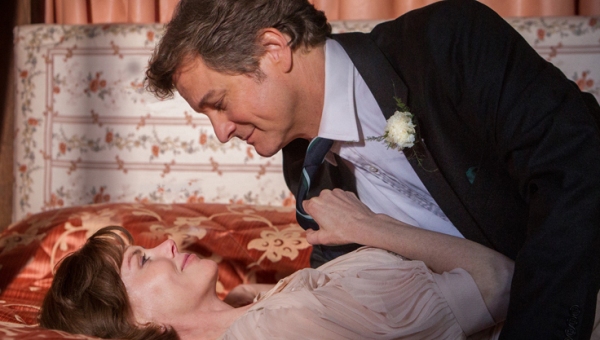 Following swiftly in the footsteps of 12 YEARS A SLAVE and MANDELA: LONG WALK TO FREEDOM comes yet another real life tale of human brutality and endurance. After a very shaky start, THE RAILWAY MAN emerges as a modestly moving portrayal of psychological trauma and unlikely reconciliation. But Jonathan Teplitzky’s film is hamstrung by miscast stars and some extremely uneven editing, which negates much of the story’s emotional impact. What remains are honourable intentions and a reliably strong performance from Colin Firth as Eric Lomax, whose book about his experiences during World War II has been adapted by Frank Cottrell Boyce and Andy Paterson.
Following swiftly in the footsteps of 12 YEARS A SLAVE and MANDELA: LONG WALK TO FREEDOM comes yet another real life tale of human brutality and endurance. After a very shaky start, THE RAILWAY MAN emerges as a modestly moving portrayal of psychological trauma and unlikely reconciliation. But Jonathan Teplitzky’s film is hamstrung by miscast stars and some extremely uneven editing, which negates much of the story’s emotional impact. What remains are honourable intentions and a reliably strong performance from Colin Firth as Eric Lomax, whose book about his experiences during World War II has been adapted by Frank Cottrell Boyce and Andy Paterson.
THE RAILWAY MAN kicks off in unlikely fashion as a gentle rom-com, with self-confessed trainspotter (or “railway enthusiast” as he prefers to call himself) Eric (Firth) bumping in to Patricia (Nicole Kidman) on a carriage in 1980. The two get chatting, romance quickly ensues and before long they’re living together in matrimonial bliss. Until, that is, Lomax’s past life as a soldier and POW in Burma comes back to haunt him. Plagued by traumatic memories and shocking mood swings, Patricia is at a loss to know what to do. She approaches his former army pal Finlay (Stellan Skarsgård) to see if he knows what might be behind it. Finlay relates the tale of his and Lomax’s capture and torture by the Japanese, along with their gruelling stint as slave labourers on the Burma Railway. When Finlay discovers that one of their captors is not only still alive, but provides guided tours around their former prison, Lomax sets off to avenge both himself and his comrades.
The story moves in fits and starts, huffing and puffing uphill while the audience looks impatiently at their watches
Despite promising a more unconventional wartime drama than might be expected, the early stages of the film are as clunky as one of Lomax’s beloved locomotives. The jarring device of flashing backwards and forwards from 1980 to the war and back again fails to build any narrative momentum or emotional involvement. Competing with the initial romance and Lomax’s subsequent mental breakdown is the wartime story, with young Lomax (Jeremy Irvine effectively evoking a young Colin Firth) and his fellow POWs attempting to escape their Japanese captors. A throughline never emerges during the first half thanks to this editorial clumsiness; the story moves in fits and starts, huffing and puffing uphill while the audience looks impatiently at their watches wondering if the wrong sort of leaves have fallen on the script.
The jumble of genres finally beings to settle down during a more focussed second half, when the flashbacks give way to Eric Lomax’s attempt to avenge his comrades and himself. It’s no secret that Lomax and Nagase (Hiroyuki Sanada) eventually became good friends, right up until the latter’s death a few years ago. The extraordinary forgiveness shown by Lomax is rightly celebrated by this film, and the denouement just about succeeds in conveying something of the bewildering awe which must have accompanied the moment of reconciliation. Colin Firth has now perfected his oh-so-English, reserved, stiff-upper-lip type, and convincingly portrays the man’s rage and heartache. A dowdy Nicole Kidman has a pretty thankless role as the wife who is there to support and do the washing up; one gets the sense she was only cast in order to open up additional avenues of funding.
But Skarsgard is the real weak link in the cast. To be fair, his character is saddled with the awkward duty of both setting up the flashbacks and then setting up the revenge attempt. He pops up whenever the story threatens to get interesting and tends to stop it in its tracks, and Skarsgård’s brittle performance rings hollow alongside that of Firth’s. A noble attempt to tell an incredible tale then, but one that fails to stir in the way that it should.
httpvh://youtu.be/bbS_dYEwf2M


Can one really dress up a personal dissatisfaction with the structure of this film as ‘while the audience looks impatiently at their watches wondering if the wrong sort of leaves have fallen on the script’ ? – maybe I am blind to this ‘shaky start’ or ‘jarring device of flashing backwards and forwards’, but I question whether that shakiness or jarring is objectively present.
Again, with ‘He [Stellan Skarsgård] pops up whenever the story threatens to get interesting and tends to stop it in its tracks’, the language of ostensible objectivity seeks to disguise what is probably just an individual niggle about what and how this film should have been, masquerading as a statement of fact.
Can I dress it up using those words, Mr Apsley? Looks like I just did. 🙂 Can a review not include “individual niggles”? Isn’t a review supposed to communicate the views of the reviewer about the film?
The first paragraph, above, is not communicating ‘the views of the reviewer about the film’, it – maybe metaphorically – is imputing the reviewer’s impatience to the rest of the audience, when maybe he has no idea whether they agree with him…
No, it’s definitely communicating the views of the reviewer about the film.
I’d actually argue almost all reviews are “masquerading as a statement of fact”. They are but a collection of ‘niggles’ or bits of praise depending on whether the reviewed liked it or not. The best that can be done is subjective observation with objective analysis, as done here I believe.
Oh, I welcome that contribution, Jim :
Just objected to the sarcastic, figurative assertion on the part of the reviewer (as if his view needs bolstering ?) that everyone else in the screening was as fidgety and impatient as he : while the audience looks impatiently at their watches wondering if the wrong sort of leaves have fallen on the script.
Nuff said, but ta, Jim !